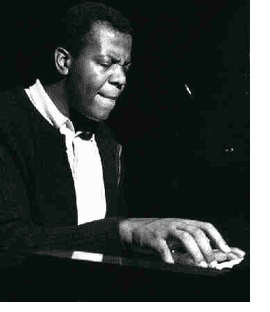Black History Month-Larry Young

There have been 2 well-known organists whose fathers were also organists and who played a big part in their career.
One was Joey DeFrancesco, whose father, 'Papa' John was the first to notice young Joey's prodigious talents at the ripe old age of five and schooled DeFrancesco.
The other was Larry Young, of Newark, NJ(October 7, 1940-March 30, 1978).
He wasn't here long but the mark he left on jazz and jazz organ stays with us today.
During the golden age of organ jazz in the 50s and 60s there were several centers of jazz organ. Among them was Philadelphia area where Wild Bill Davis and Jimmy Smith started out. Another important one was Newark, New Jersey, where Larry Young was born and remained for much of his life.
Sometimes when somebody or something exceeds expectations you might say 'they are off the chain'.
Larry Young's gift on the organ was off the chain.
Harmonically, rhythmically, really his overall vision of jazz organ just came from a different place, similar to the way that saxophonist John Coltrane redefined the way jazz was played about that same time. In fact the two were friends, but Young died before they ever recorded together.
Bob Blumenthal states on the liner notes of the re-release of 'Unity' is that if he plays a Larry Young track for a jazz connosieur who isn't fond of jazz organ, a convert will be made to the appreciaters of this music.
'Unity', then is indeed not only one of jazz organ's finer moments but also one of jazz's greatest moments as well.
There's no reason it shouldn't have been. Featuring guitarist Grant Green, Coltrane's drummer Elvin Jones, trumpeter Woody Shaw, and saxophonist Joe Henderson, these are people who were either already at the top of their form, or for Shaw, a warm introduction to that world.
There is not a bum track on the whole recording. 'Monk's Dream', a Thelonius Monk tune features Jones and Young in a duet that turns the groove around on its head. The elder Jones was already a master and legend on drums, and Young is his colleague.
The tune is based on a simple I-IV-V blues progression in a medium 3/4 time, but the way Young plays it keeps the blues feeling very subtle and disguised.
Another composition, Woody Shaw's 'The Moontrane' is another departure from the blues-drenched jazz organ style that Smith started. A very modern piece for the times, it announces a new day for jazz organ.
Another recommended Larry Young CD is 'The Art of Larry Young', a CD that recalls the tunes discussed here, plus a other highlights from Young's career.
'Talkin' About J.C.', a Grant Green tune honoring Coltrane that features Young on the main tune is another jazz blues arrangement that Green and Young both disguise, in composition and the way they perform the tune. It was originally featured on a Grant Green solo CD, but because of Young's superb playing on this track, it can't be left out on such a compilation. Jones again is the drummer and it just doesn't get much better than this.
Young also presented a recording of Miles Davis 'Seven Steps to Heaven'. It was originally recorded on his 'Of Love and Peace'. The side musicians were Newark locals, who weren't really in the same rarefied space that Young was.
This underscores a peculiarity of Young's talent, his preference for Newark and its musicians and his continuing expanding ability and vision for the instrument despite who he's playing with. They seem out of their environment with Young, trying too hard to plug into that 'jazz after Coltrane' vibe.
No relation to Smith, Organist Lonnie Smith recorded 'Seven Steps' several years later coming from the same place as Young did, with sidemen that could share that same vision.
Young also did many other solo recordings, as well as playing with Miles Davis on 'Bitches Brew' and Carlos Santana and Jimi Hendrix.
One of his last recordings was with drummer Tony Williams 'Lifetime' group, featuring Jack Bruce on bass and John McLaughlin on guitar. If the forementioned Young recordings push the boundaries of jazz, this one 'breaks' the boundaries of jazz. It has been said that this is an 'explosive' recording, it certainly is raw, Young is driving his Leslie through guitar amps, getting a really dirty sound.
Young was frustrated that his recordings didn't break the charts like his predecessors that we have discussed did. In the 1970s he did try to release some recordings on Arista that were designed to be more commercially successful. On those records he turned more towards the synthesizers that played a part in temporarily driving jazz organ scene and the Hammond organ almost out of existence.
The 'Force' was so strong with Young that he was just as much out of his element in this context as those who recorded with him on 'Of Love and Peace'.
Historically his death just prior to age 40 due to internal bleeding from a ruptured spleen marked the end of organ jazz, and it and and the Hammond organ would not be considered seriously again until Joey DeFrancesco revived interest in it in the 1990s with his prodigious talents.
Contemporary jazz organists such as Sam Yahel and Larry Goldings almost seem to have started where Young left off, departing from a bluesy jazz sound to a more adventurous journey.
Young is my favorite of all of them.
More information can be found at Pete Fallico's website:
Larry Young's website, maintained by his son:
www.larryyoungmusic.com
Larry Young Chapter 1 http://www.doodlinlounge.com/Stories/Young.html
Larry Young Chapter 2
http://www.doodlinlounge.com/Stories/Young2.html


